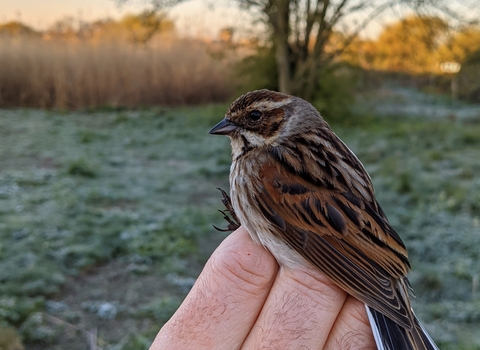A volunteer group whose aim is to study the birds of Walthamstow Wetlands, to understand their breeding success, longevity, and movements in the wider Lee Valley catchment area and as an important stepping-stone for resident and migratory species by trapping and ringing them.
Based in Greater London, with good transport accessibility, the group plans to engage with the public using bird-ringing demonstrations and seek to act as a training group to engage with interested people who wish to get involved in bird ringing. The group also hope to contribute to our scientific understanding of the birds that utilise the Wetlands and, in particular, on the information collected at Walthamstow. This will help inform future management of the Wetlands and other sites in the Lee Valley.
Please note: A waitlist is in operation for any ringing opportunities at Walthamstow Wetlands. The waitlist is currently considerably long and the group have recently taken on two new trainees, therefore capacity to introduce new members will not be available in the near future. In the meantime, please visit the British Trust for Ornithology (BTO) for a list of trainers available to contact for training opportunities.
Ringing
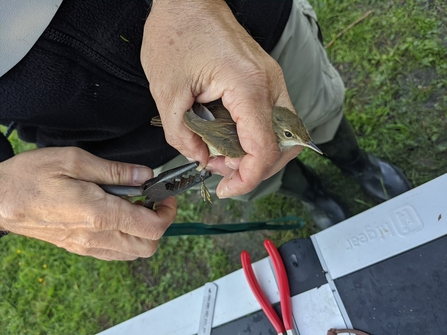
Ringing a reed warbler Credit Ildikó Connell
Bird ringing involves the placing of numbered metal and/or coloured plastic rings around the legs of birds. Birds are caught in soft, finely-meshed nets – ‘mist nets’ that are strung between poles or other uprights. Birds are caught in a manner that is safe and enables a ringer to carefully remove them from the net, hold each one in a safe manner to keep it calm and place the ring(s) using a special tool around – usually – one leg. Details of each ring(s), which are unique to the bird and the date and site of ringing, are recorded, so that when birds are caught in future we know where they came from and the time when they were ringed.
If you would like more information about bird ringing, please visit the British Trust for Ornithology (BTO).
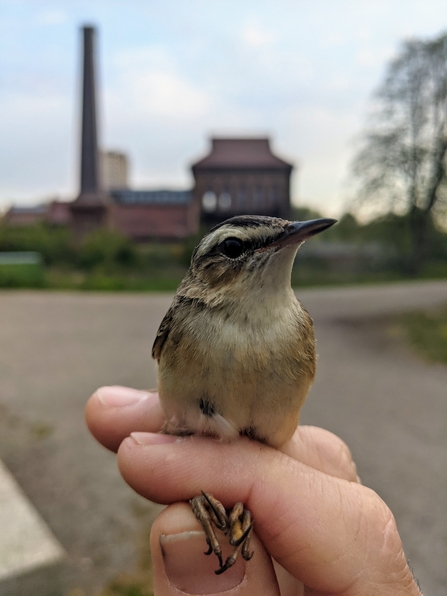
Sedge warbler credit Pete Salter
Ringing is a tool to enable various studies to be undertaken and questions that are asked about birds to be answered. At the basic level ringing birds gives information on movements, migration, and longevity. However, various projects or different types of bird ringing can give a lot more information on subjects such as juvenile dispersal, behaviour, population levels, breeding success or juvenile or adult survival rates year on year.
The safety and welfare of all birds caught and ringed is critical to the success of ringing and therefore the strictest ethical procedures are applied under the guidance of trained and licensed ringers. As the Wetlands are mostly a Site of Special Scientific Interest (SSSI), and part of a Special Protection Area and Ramsar site, consents are required from Natural England for ringing to take place. Data from ringing informs national and regional datasets of the respective species.
Study site and ringing activities
Study site
About Walthamstow Wetlands
Walthamstow Wetlands is a 211-hectare site comprising ten reservoirs that provide drinking water for London, and which are internationally recognised for their importance for migrating birds – particularly overwintering wildfowl.
Walthamstow Wetlands is notable for its reedbed and scrub habitat which is home to most warbler species (Cetti’s warbler, reed warbler, sedge warbler, chiffchaff, blackcap, whitethroat, and lesser whitethroat). By comprising part of the wider Lee Valley catchment area, the Wetlands is an important steppingstone for resident and migratory species.
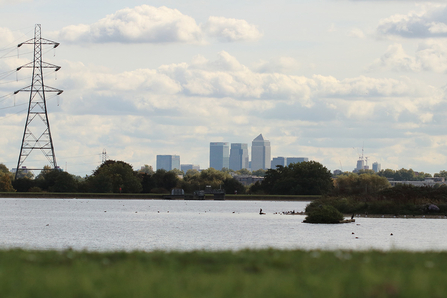
Walthamstow Wetlands City View
Notable species
Breeding grey heron is one of the notifiable features of the Walthamstow Reservoirs SSSI. Walthamstow supports nationally significant numbers of breeding grey heron, reaching a level that placed the Reservoirs in the country’s top five breeding sites. In 1993, a peak of 138 pairs were recorded across the entire site. 42 pairs recorded in 2018 and 33 pairs in 2021. The reason for this decline is unknown but it is thought they may have moved elsewhere in the Lee Valley. Ringing would help establish a clearer picture of the movement.
Little egret also colonially nests with grey heron on Reservoir 1, 2 and 3, and the first breeding record of this species in London was at Walthamstow Wetlands in 2006. Since then, numbers have increased to 37 pairs in 2019 and 21 in 2021.
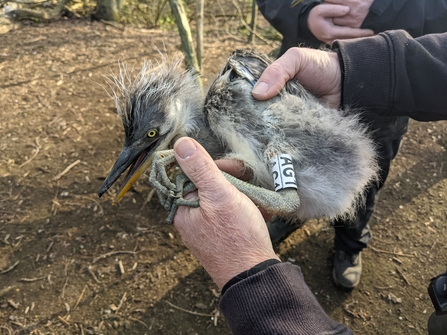
Ringed heron chick Credit Pete Salter
© Adam Wilson
Ringing activities
General ringing
This is the ringing of full-grown birds that are trapped mainly with mist nets outside of the CES monitoring period (see below). Each caught or re-trapped individual is examined to identify its age, sex and biometric measurements are taken.
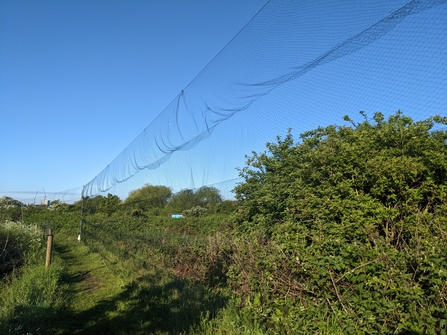
Bird ringing nets Credit Ildikó Connell
CES ringing
Constant Effort Site project (CES). This is standardised ringing where the setting/number of nets are the same and consistent ringing (ten-day periods) takes place over a season. This is to monitor a range of things including valuable trend information on an abundance of adult and juveniles, productivity, and adult survival rates for 24 species of common songbird. There are over 140 CES sites across Britain and all contribute to the national picture.
Nest recording scheme ringing
As part of the BTO Nest Recording Scheme, ringing of nest box robin, blue and great tit pulli (a young bird or nestling that is not yet able to fly) in 2018 was carried out. This may happen in the future as this activity feeds into CES data.
Heron and egret ringing
In collaboration with the Southern Ringing Group, colour-ringing pulli (a young bird or nestling that is not yet able to fly) of grey heron and little egret on reservoirs 1, 2 & 3 is carried out to study the movement and possible displacement of individuals from the Walthamstow Wetlands colony as part of the Walthamstow Wetlands conservation management plan. Visiting the islands on Reservoirs 1, 2 & 3 during key breeding season to record a number of breeding pairs of grey heron and little egret.
Mute swan ringing
Mute swans are colour-ringed as part of the East Anglian Swan Study, are ringed throughout the year and carry a distinctive red ring.
Geese ringing
In partnership with Phil Belman, 257 and 148 Canada geese were ringed in 2018 and 2019 respectively during moult round ups. Phil is a ringer who has been studying urban geese in London since the ’90s. Additional geese ringing takes place in all seasons, since 2018, 465 Canada geese and 35 graylag geese have been ringed at Walthamstow Wetlands. A better understanding of the population dynamics of a bird that is considered problematic on some sites will help to inform any IMS (Integrated Monitoring Strategy) that is developed for the Wetlands.
Training to ring
The group also seeks to act as a training group to engage with interested people who wish to get involved in bird ringing and contribute to science and in particular the information collected at Walthamstow Wetlands.
Please note: A waitlist is in operation for any ringing opportunities at Walthamstow Wetlands. The waitlist is currently considerably long and the group have recently taken on two new trainees, therefore capacity to introduce new members will not be available in the near future. In the meantime, please visit the British Trust for Ornithology (BTO) for a list of trainers available to contact for training opportunities.
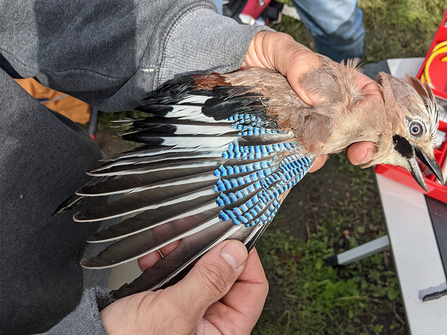
Jay wingspan Credit Ildikó Connell
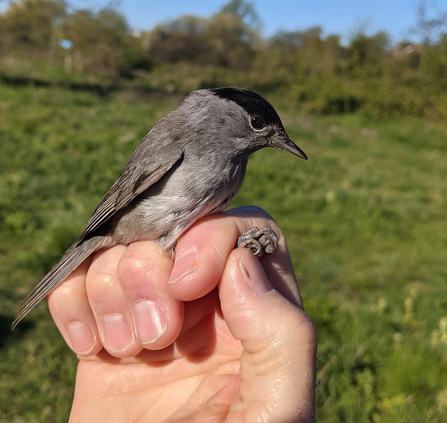
© Pete Salter
More information
Future plans
The plan for the group longer term is to operate with a slow burn testing the value of the CES over a year or two and if visitors and other site users are amenable to the activities of the group ringing activities may be expanded. Other possible projects of interest may be on ringing wildfowl, gull and tern pulli from the rafts or cormorant ringing. It is hoped that this activity will complement the various other surveys and monitoring that already takes place on-site and will provide more detailed information on the conservation and management activities on site.
How to report a ringed bird
If you are lucky enough to spot a ringed bird at Walthamstow Wetlands you can do one of four things:
1. If it is a Canada/Greylag Goose with a metal ring number, complete this record form, noting the ring number, species, if it was dead or alive and a few other details.
2. If it is a Little Egret, Grey Heron, Black Headed Gull with a colour ring contact Paul Roper via email, noting the ring number, species, if it was dead or alive and a few other details.
- Little Egrets will have a colour ring on each leg above the knee. It’ll be black with a white letter or number and orange with a black letter or number.
- Grey Heron will have a single colour ring above the knee. It’ll be white with three or four numbers and the letter R.
3. If it is Mute Swan with a colour ring then contact Mike Reed via email, noting the ring number, species, if it was dead or alive and a few other details.
- The Swan will have a single colour ring above the foot. It’ll be a red ring with a black code (numbers and letters). These birds are ringed as part of the East Anglian Swan Study Group that Mike runs.
4. Any other birds (including any of the above species that do not have the mentioned specific rings on) with rings either read in the field or found on dead individuals need to be submitted to the BTO website.

